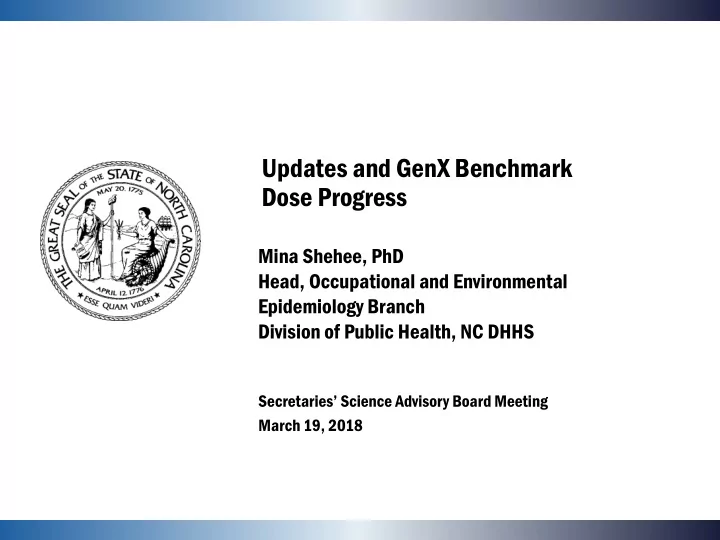

Updates and GenX Benchmark Dose Progress Mina Shehee, PhD Head, Occupational and Environmental Epidemiology Branch Division of Public Health, NC DHHS Secretaries’ Science Advisory Board Meeting March 19, 2018
Overview • Updates − EPA Goal − Peroxisome Proliferator-Activated Receptor (PPAR) • Benchmark Dose Progress 2
EPA Goal • EPA is working on a GenX goal • Indicate goal of 5 months, but timing uncertain • DHHS intending to continue work on benchmark dose modeling 3
Peroxisome Proliferator-Activated Receptor (PPAR) • Group of nuclear receptors • PPARs are activated by a variety of endogenous and exogenous compounds including PFAS • Regulate genes involved in fatty acid metabolism, inflammation, and proliferation • Three PPARs in mammals − PPAR α • Highest expression in liver, intestine, kidney, heart, and adipose tissue − PPAR β • Highest expression in intestinal epithelium, liver, and keratinocytes − PPAR γ • Highest expression in adipose tissue and macrophages 4
PPAR α Mechanism of Action: Relevance to Human Health • Corton et al. − Argues that a number of agents, including PFAS, cause liver tumors in rodents via a mode of action that includes activation of PPAR α , and that this MOA is not relevant to humans. Corton et al. 2018 5
PPAR α Mechanism of Action: Relevance to Human Health • Some PFAS effects associated with activation of PPARα • Evidence of interspecies difference in levels of PPARα expression and responsiveness • PPARα -independent mechanisms also involved in PFOA and PFOS toxicity, including liver toxicity • Relevance of these endpoints to human health cannot be excluded EPA Lifetime Health Advisories for PFOA and PFOS; ATSDR’s draft ToxProfile for PFAS 6
Benchmark Dose Modeling Progress • OEEB staff reviewed 7 studies: − Represent all repeat-dose oral toxicity studies − Other GenX studies have been reviewed, but were not considered relevant for drinking water exposures − Benchmark dose modeling is focused on GenX only • Data tables were created for each statistically significant endpoint for GenX 7
Benchmark Dose Modeling Progress • Seven (7) studies: − 28-Day Oral (Gavage) Toxicity Study of H-28397 in Mice with a 28-Day Recovery − 28-Day Oral (Gavage) Toxicity Study of H-28397 in Rats with a 28-Day Recovery − H-28548: Subchronic Toxicity 90-Day Gavage Study in Mice − 90-Day Oral (Gavage) Toxicity Study of H-28548 in Rats with a 28-Day Recovery − H-28548: Combined chronic Toxicity/Oncogenicity Study 2-Year Oral Gavage Study in Rats − Oral (Gavage) Reproduction/Developmetal Toxicity Screening Study of H- 28548 in Mice − Oral (Gavage) Prenatal Developmental Toxicity Study of H-28548 in Rats 8
Benchmark Dose Modeling Progress • Organization by study: − Two data types: continuous and dichotomous − Four to eight parameters − Organized into tables 9
Benchmark Dose Modeling Progress Parameters (n = 24) • Body weight • F 1 Balanopreputial Separation • Hematology gy • F 1 Vaginal Patency • Serum Chemistry • F 1 Post-Weaning Body Weight • Macroscopic • F 1 Food Consumption • Organ weights • F 0 Microscopic • Microscopic • Maternal Body Weight • Food Consumption • Gravid Uterine Weight • Clinical Chemistry • Maternal Macroscopic • Urinalysis • Laparohysterectomy Data • Coagulation • Maternal Microscopic • F 0 Body Weights • Fetal Morphology • F 0 Organ Weights • F 1 Body Weight 10
Benchmark Dose Modeling Progress Endpoints for Hematology Parameter 11
Example table – Continuous type data Study title and data type at the top of each page Endpoint (and units if applicable) at the top of each table Statistical significance noted if analyses provided by study authors 12
Example table – Dichotomous type data Endpoint Study title and data type (and units if at the top of each page applicable) at the top of each table For histopathology results, severity noted 13
Benchmark Dose Modeling Requests N.C. DHHS requests input from the SAB on the following: 1. Review compiled data tables. Provide guidance on the endpoints deemed critical and/or most relevant to human health. These will be the endpoints OEEB will input into BMD software. 2. Provide guidance/justification on benchmark response levels for each endpoint from above. For example, guidance on use of 1 SD change from the mean versus 2 SD (continuous data), 10% or 20% change for dichotomous data. Each endpoint may have a different BMDR. 14
Benchmark Dose Modeling Next Steps OEEB staff will use EPA’s BMD software to model selected • endpoints at recommended response levels. N.C. DHHS will provide the outputs of the model (BMDLs) for SAB • consideration and recommendation for use as a point of departure. 15
Questions? 16
Recommend
More recommend